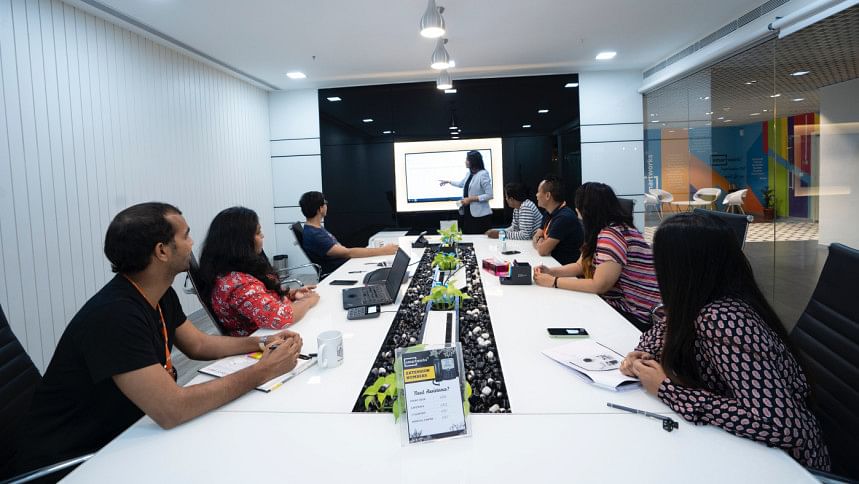How to be a stunner at work and university presentations

Giving a presentation is always daunting - whether you are presenting to your fellow classmates, faculty members or your colleagues and bosses at work. However, with the right combination of PowerPoint tips, public speaking skills and plenty of practice, you can present like a pro in no time. Here are some key points to keep in mind when you're giving a presentation in your classroom or workplace.
Public speaking
Though public speaking skill is required in both work and academic presentations - there is a difference between the two settings. Work presentations are primarily designed to inform and persuade, rather than to entertain and inspire. They tend to be detail-focused and data-intensive, with assertions proven with facts and less reliance on anecdotes. They are also rooted in a clear, logical structure, as opposed to a performance. The audience can vary from an intimate setting to sometimes a large conference room.
On the other hand, academic presentations can be on any topic that's light and conversational to an in-depth research presentation. The audience is generally your classmates and teachers, so you should feel more relaxed explaining your points to them. Even though academic presentations do come with the pressure of grades, you can still regard them as valuable practice sessions to hone your public speaking skills further.
Be prepared
It is very important to be well-prepared for any presentation. The preparation phase must include a thorough study of the topic you are presenting, time management, pinpointing the keywords, awareness regarding your target audience and ensuring all your audiovisual tools are functioning well. The tools may include a PowerPoint slide, videos, images, the sound system, projectors, etc. You must make sure all the tools necessary to make the presentation go smoothly are operating well beforehand.
The preparation part also includes practising what you will be delivering. Try to visualise yourself giving a great speech. Organise your material in a way that is comfortable to you - by using a script, outline, notes or 3x5 cards. It's best to number the points or cards. Proofreading all the material will minimise mistakes on screen and in speech.
Inform with your slides
Making a good presentation starts with crafting the content. It is important to create an easy-to-follow structure. The presentation needs an introduction, body and conclusion. Start with a compelling intro, power it up with facts, quotes and evidence that back up your main points and sum it up with key takeaways. Avoid making really lengthy presentation slides as they can bore your audience with overwhelming data. Experts suggest 10-12 slides for a moderate presentation. This way even if your presentation is 30 minutes long, your audience will get a chance to digest the on-screen messages in line with your speech. Use concept maps to structure the slides to keep them concise and clear.
You can think of going savvy with the design details. Both at work or university, a well-thought-out design can make all the difference. Bright colours can dazzle, but too many can be off-putting. Use the colours most relevant to the messages. It is best to stick with one or two colours except for black and white so it looks consistent. For academics, shiny and neon colours should be avoided.
A consistent design makes your work more professional. Stick with one font and one size. You can change the emphasis with your words later, but the on-screen text is better uniform for cohesive messages. Keep your texts aligned as much as possible. Using full-screen images with an overlay for texts can also light things up.
Incorporating other audiovisual tools can engage the audience more. For work presentations, you can add short videos that tell a story, a product demo, or a mock-up graphic on a slide instead of a flat screenshot. For academic presentations, add in graphic charts, data lists, short informative videos, and any clips that support your topic - quotations, dialogues or mind-stirring questions.
What to wear (and not to wear)
Your presentation outfit should always look professional. Generally, fitted pieces give a more professional and ready-to-present look. You can wear formal shirts with a matching tie, suit, sober-coloured blazers with formal pants, and pencil skirts with modest tops that carry a professional look. You can also try sarees, but avoid ones with shiny, bejewelled embroidery and choose a plain and weighted fabric. At work presentations, all of the above can be worn as well. Choose simple jewellery or accessories that don't steal the light from you, like a watch or necklace that flashes too much.
Make sure your outfit is breathable. Avoid shoes that hurt you or can cause you to stumble. Steer clear of any clothing that restricts your movements or makes you self-conscious. Make sure your outfit walks with you and works with you. Sticking to dark colours, simple shapes and smooth lines works the best in most cases. Avoid wearing casual, like t-shirts, loose shirts, jeans, and baggy dresses that take away the professional look. Baggy, ill-fitting tops or pants can make you look dishevelled and sloppy - the last thing you want to come across as.
Presenting in a group
If you are presenting as a group or with a colleague, then flexibility is crucial. Divide sections of the presentation carefully to avoid overlap or exaggeration. Build the presentation together and let every member know what each speaker will say. Make sure the length of time per speaker is agreed on. If there is a group leader, it is important to put your trust in them just as you'd want others to trust your strategy if you were leading. But most importantly, rehearse as a team and create a unified look for your presentation.
Deliver in style!
Remember to talk to your audience to encourage questions from them. Project enthusiasm for the topic and present it in an organised manner, avoiding jargon to not alienate any listeners. Emphasise your most important points, more than once if needed, and use natural gestures and voice inflexion where necessary. Maintain eye contact and never read your presentation word for word.
It all comes down to delivering what you have worked hard on. Be it university or work, the first challenge is to have the attention of your audience. Audiences usually make up their minds in the first seven seconds, so make the first movements count. You can open with a little story related to your topic, ask a rhetorical question to frame a topic and introduce ideas, insert a relevant metaphor or popular culture reference, etc. But be careful of who your audiences are and to what level you can be inventive with them. Reading the room and crafting your way in - casually or strictly professionally, is something you need to figure out.

 For all latest news, follow The Daily Star's Google News channel.
For all latest news, follow The Daily Star's Google News channel. 








Comments